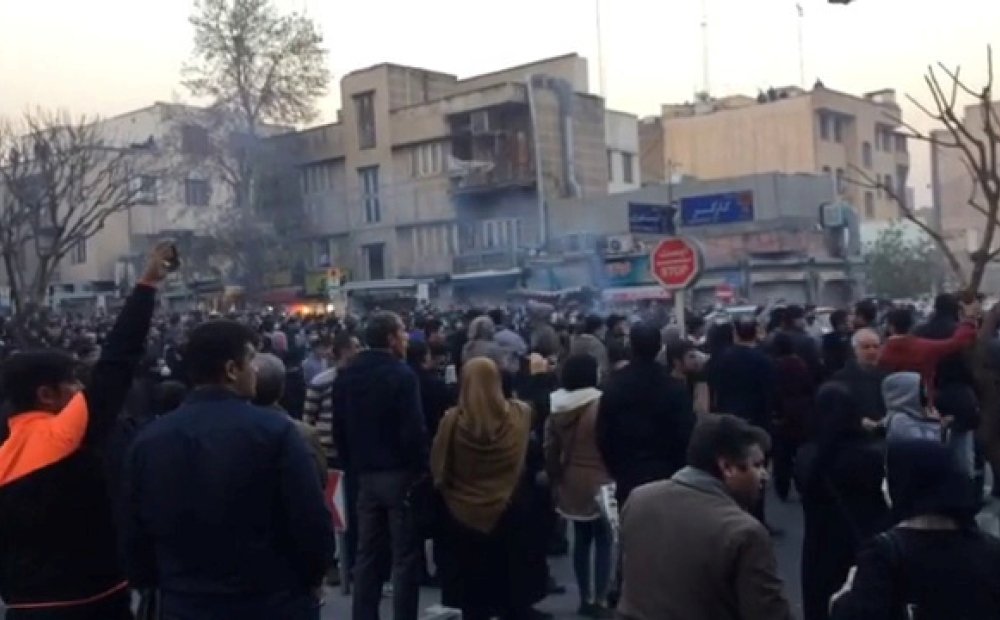Protests in Iran: Their Motives and Meaning

As protests sweep the Islamic Republic, Iran-watchers are wrestling with their precise triggers and consequences. These demonstrations, leaderless and unorganized, may well fade in the face of the repressive powers of the state, but what are their larger significance for Iran's domestic and foreign policy? What opportunities or risks do they present for the Trump administration's approach to the country and the region?
In this Ground Truth Briefing, three veteran Iran analysts and journalists addressed these issues.
Due to technical difficulties, a portion of the audio is missing. Below is the full transcript of Haleh Esfandiari's remarks in addition to selected quotes from the other speakers.
Haleh Esfandiari (full statement)
"For the last ten days, we have witnessed a series of protests across Iran. These were not ten days that shook Iran at its roots, but surprised everybody in Iran, and they were significant.
In my remarks, I will touch briefly on the causes of the unrest, on the official reaction to the protests, and finally, I will try to assess their significance and what may happen next.
The protests, as we know, erupted in the city of Mashad and then spread to towns and cities all over the country. The protests began as grievances against economic conditions and understandably so. The cost of living is high, wages are inadequate, good jobs are hard to find, and unemployment, particularly among the youth, is high.
But the protests quickly also took on a political tone. Protesters shouted 'down with the dictator,' a clear reference to Ayatollah Khamenei; and death to Rouhani, the president who has disappointed hopes for prosperity and opening up the system. They called for an end to clerical domination of power. They also called for an end to Iran’s expensive involvement in Syria, Lebanon, and Gaza and for the money to be spent for improving the life of the poor in Iran. All of this is significant.
Protests were extremely widespread. The protestors came from among the young, unemployed, and the marginalized elements in society — the very base of the regime. And the slogans touched on the principal figures and foundations of the system. To take one example, the principle slogan of the revolution in 1979 was 'Independence, Freedom, Islamic Republic.' On this occasion, the protestors shouted 'Independence, Freedom, Iranian Republic.'
The government’s reaction to these protests has been of two kinds: President Rouhani and the reformists acknowledged that the people had cause for economic discontent and also the right to protest peacefully, although Rouhani drew the line at violent protests and disorder. But the Supreme Leader, while conceding that people’s economic problems need to be addressed, nevertheless characterized the unrest as inspired by foreign money, intrigue, and CIA machinations. The commander of the Revolutionary Guards labled the protests as 'sedition’ and the commander of the police said any unrest would be firmly put down.
Clearly, the policy of the regime is to acknowledge economic discontent, and to blame the Rouhani government for it, but to ignore and maintain silence over the political dimensions of the protesters. For example, the official media has not reported that the protesters were also targeting the SL, clerical rule, and foreign engagements. Increasingly in the last few days, the emphasis has been on depicting the unrest as foreign-inspired and the work of anti-regime elements. Just yesterday, the SL again described the disturbances as American-inspired.
This has been accompanied by a severe crackdown. Yesterday, a member of parliament asserted that he knows that as many as 3,337 are detained. In addition, two and maybe three detainees died in prison and the authorities claim two of these committed suicide. Given the experience of 2009, this is hard to believe.
What happens next? The government will no doubt take some steps to deal with high prices and find ways to improve conditions for the poorer classes in society. But it is hard to believe the protestors' political grievances will be addressed. A regime that attributes the unrest to foreign elements is not going to admit there is a need to make changes in the political system. The reformists recognize that unless issues of freedom and human rights and corruption are addressed, Iran will face more unrest and problems in dealing with the West, but they are in the minority. We have seen again and again that attempts by the reformists to open up the political system have failed. Former President Khatami attempted sweeping reforms but was blocked. The current president, Rouhani, tried the different tack – moderate, gradual reform – and he, too, has failed. The fact is that the hardliners dominate the state; they don’t want to lose power and they fear any change will unravel the system."
Suzanne Maloney (selected quotes)
“What is so unique and different and, I think, significant for the long term about what has taken place within Iran over the course of the past two weeks is the extent to which the protests quickly mushroomed and moved from city to city. And that kind of a challenge, both the dispersion around the country and the militancy of rhetoric that was voiced by protestors… has got to be something that provokes real concern among the leadership. Combine that with the sense that there wasn’t a source of obvious provocation and we now believe, and Iranians believe, that, in fact, the initial protest was orchestrated as an effort to focus complaints and grievances and potentially undermine President Rouhani.”
“There was never any real doubt that the government could suppress the protest, which is another curious feature about this. What we saw was the subtle capacity of the Islamic Republic to manage dissent in a way that doesn’t necessarily quickly provoke its escalation. To enable people to go out to the streets for those first weeks or two I think was probably quite deliberate in the sense that there was a recognition that a really overwhelming show of force might only spiral this out of control.”
“What we know is that this isn’t going to go away. And this is inherently political; even when people are coming to the streets to complain about the price of eggs, what they’re really looking for is a response from the government in terms of insuring that the markets work — and that is something the Islamic Republic has struggled with persistently over the course of the last four decades. And the protests won’t make the challenge of managing the economy of Iran any easier. “
“There are many Iranians who are so fed up with the system that they are prepared to risk their lives and their livelihoods simply to demand something else, even if they don’t know what that something else is. That depth of dissatisfaction and willingness of Iranians to plunge toward a more revolutionary future is something we ought to pay very close attention to… The process of gradual reform has run aground… It may simply be that it’s not possible to reform the Islamic Republic, to fix the fundamental problems of the economy, of the domestic politics, without actually getting to the nature of the regime itself. If Iranians are coming to that conclusion, we ought to listen to them.”
Robin Wright (selected quotes)
“One of the intriguing things is who might emerge from these protests as a potential leader. We have seen neither leadership nor a manifesto. We know what people are against, we’re not sure what they’re for. And that’s the missing component from the 14-month period that led to the revolution in 1979. When you had the disparate elements, whether it was the nationalists or leftist or communists… coming together under one banner. That we haven’t seen yet, and I think we need to be wary of thinking that eight days of protest is going to lead inevitably to something much bigger. I believe there will be more protests…”
“It’s clear that both by executive order and congressional action we should all expect more pressure and tightening of the screws on Iran. The mood was reflected on Tuesday when the House of Representatives passed a resolution that expressed a support for Iranians engaged in 'legitimate and peaceful protest.' It also condemned the government’s human rights abuses… So I think we are likely to see a pattern. I’d guess that we may see a waiver of sanctions in the short term but a simultaneous imposition of new sanctions for human rights abuses.”
“The big question to me is, what’s the Trump administration’s ultimate goal? It keeps talking about seeking a change in behavior... When I’ve pressed them on it, it’s clear that they want a change of behavior that is so profound and so unlikely by the Islamic Republic that its vision of an acceptable Iran as an interlocutor amounts to both a different set of actors in power and a different type of government. I think that was reflected in President Trump’s tweet on New Year’s Day.”
Introduction

Moderator

Panelists



Hosted By

Middle East Program
The Wilson Center’s Middle East Program serves as a crucial resource for the policymaking community and beyond, providing analyses and research that helps inform US foreign policymaking, stimulates public debate, and expands knowledge about issues in the wider Middle East and North Africa (MENA) region. Read more
